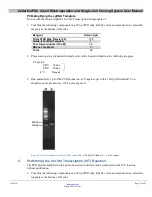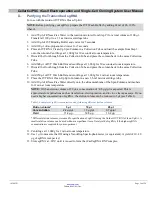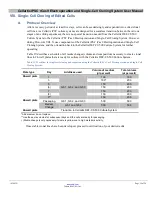
Cellartis iPSC rCas9 Electroporation and Single-Cell Cloning System User Manual
(030619)
takarabio.com
Takara Bio USA, Inc.
Page 20 of 24
B.
Single-Cell Seeding into a 96-Well Plate
To optimize the survival rate and expansion potential during single-cell seeding, use cells that are in an
early proliferative state. We recommend starting with a
confluent but not dense
culture, corresponding to
a density of 0.8–1.5 x 10
5
cells/cm
2
(Figure 9).
1. Coating a 96-Well Plate
1.
Dilute the required volume of Cellartis iPSC Single-Cell Cloning DEF-CS COAT-1 (SCC-COAT-1)
in D-PBS +/+ prior to use. Make a 1:10 dilution. Calculate the amount of diluted coating solution
required depending on the number of wells to be used (50 µl of diluted coating solution per well: see
Table V for guidance).
Table V. Preparation of coating solution for a 96-well plate.
Number of wells
(96-well plate)
Volume of diluted
coating solution (µl)
Volume of
SCC-COAT-1 (µl)
Volume of D-PBS +/+ (µl)
1
50
5
45
2
100
10
90
96
4,800
480
4,320
n
50 x n
(50 x n)/10
(50 x n)
– (volume of SCC-COAT-1)
2.
Mix the diluted SCC-COAT-1 solution gently and thoroughly by pipetting up and down.
3.
Add the diluted SCC-COAT-1 solution to a 96-well plate for single-cell seeding, making sure the
entire surface of each well is covered.
4.
Place the cell culture plate in an incubator at 37°C ± 1°C, 5% CO
2
, and >90% humidity for a
minimum of 3 hr.
5.
Aspirate the diluted SCC-COAT-1 solution from the cell culture plate just before use.
Figure 9. Recommended density of starting culture used for single-cell cloning.
Representative image shows the morphology of cells with a density of 1.5 x 10
5
cells/cm
2
at
10X magnification. Scale bar = 100 microns.






















